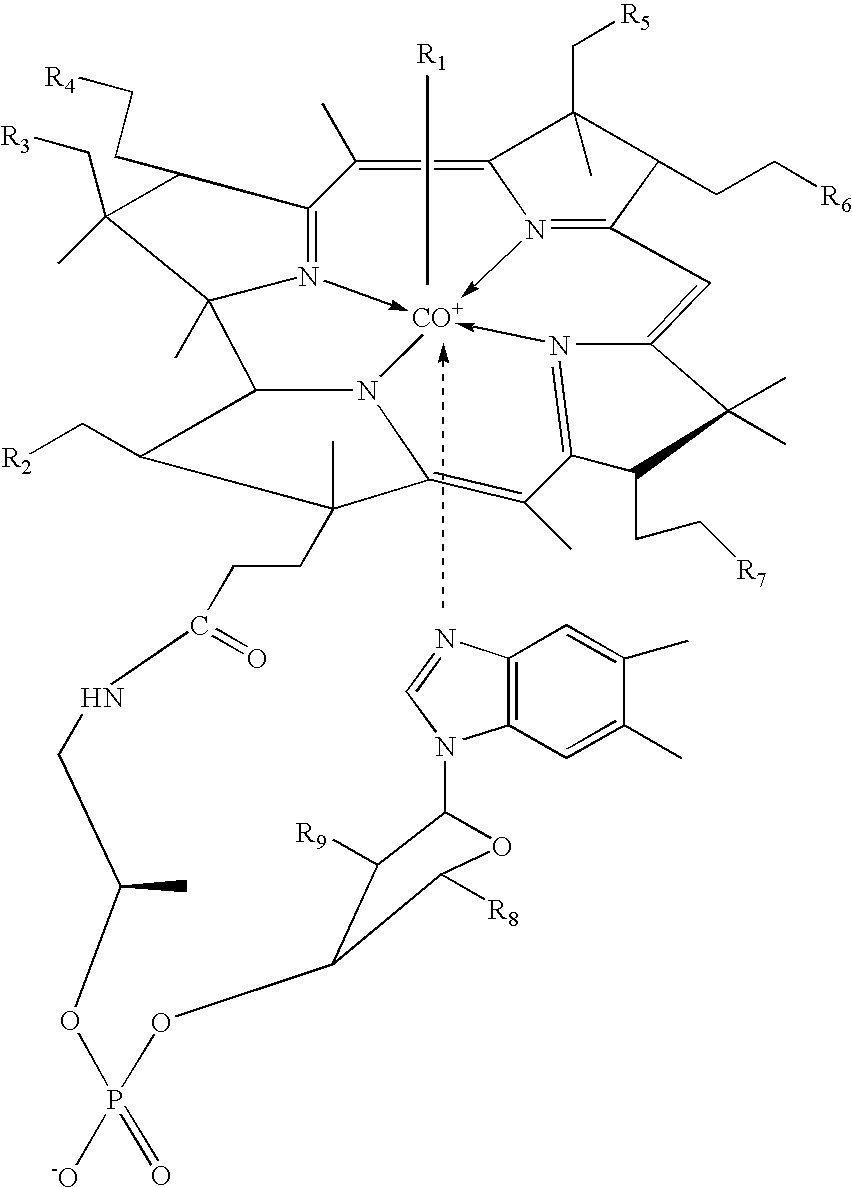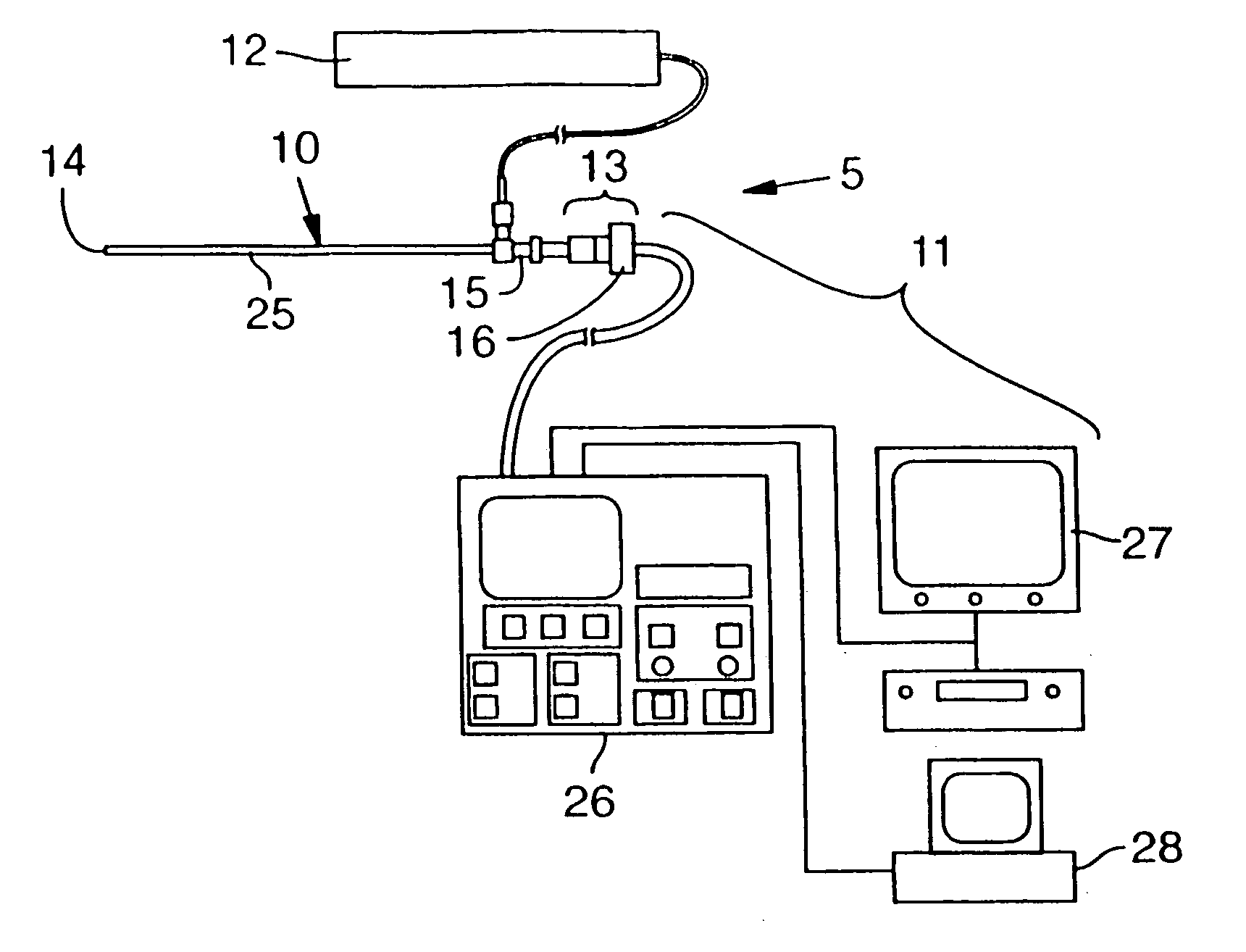Device and method for the photodynamic diagnosis of tumor tissue
a tumor tissue and photodynamic diagnosis technology, applied in the field of tumor tissue photodynamic diagnosis devices and methods, to achieve the effect of convenient identification and retrieval
- Summary
- Abstract
- Description
- Claims
- Application Information
AI Technical Summary
Benefits of technology
Problems solved by technology
Method used
Image
Examples
example 1
Synthesis of Fluorescent Cobalamin by Attachment of the Fluorophore to Cobalt
[0098] As a visual indicator of cobalamin localization, five fluorescent analogues of cobalamin were prepared by covalently attaching fluorescein to cobalamin. Under green light illumination, the fluorescein molecule emits yellow light that can be detected by the dark-adapted eye to concentrations lower than 0.1 ppm. This emission enables the sensitive detection of cancer cells via epifluorescence microscopy, as well as by visual inspection. Each of the five fluorescent cobalamins exhibited intrinsic fluorescence. All of these compounds were synthesized by reacting aminopropyl chloride with cob(I)alamin to produce aminopropylcob(III)alamin in accordance with published techniques. In a subsequent step, aminopropylcob(III)alamin was reacted with a variety of fluorophore isothiocyanates (i.e. fluorescein isothiocyanate, "FITC") to produce the corresponding fluorophore that is linked to cobalamin through an ami...
example 2
Uptake of Cobalamin Bioconjugates by Cancer Cells
[0100] A leukemic myeloblast preparation was made from a bone marrow aspirate of a 61-year old patient having acute myelogenous leukemia (AML) M1 (minimally mature myeloblasts in the FAB classification). Cells were treated three days post-harvest with a fluorescent cobalamin prepared as described in Example 1. Differential uptake of fluorescent cobalamin analogues, as determined by fluorescence microscopy or fluorescence flow cytometry, in normal and leukemic human bone marrow cells was found. The difference between normal marrow cells and leukemic myeloblasts (cancer cells) is particularly noteworthy, with no detectable cobalamin being taken up by normal cells. A bone marrow sample from a healthy individual showed no fluorescent labeling. Uptake of a doxorubicin-cobalamin conjugate, originally synthesized as a potential chemotherapeutic compound, was seen in P-388 marine leukemia cells and in HCT-116 human colon tumor cells. These re...
example 3
Preparation of Cyanocobalamin Monocarboxylic Acids
[0101] The b-, d-, and e-monocarboxylic acids were prepared by acid-catalyzed hydrolysis of cyanocobalamin. See FIG. 2. Briefly, cyanocobalamin (527.0 mg, 0.389 mmol) was placed into a 100 ml round bottom flask and dissolved in 40 ml of 0.5 M HCl. The flask was placed in a water bath at 50.degree. C. and stirred for 4 hours. The reaction was monitored via HPLC (Waters, Inc. 3.9.times.300 mm DeltaPak 100 C-18 column) using the gradient tabulated in Table 1.
1TABLE 1 0.5 M H.sub.3PO.sub.4 (pH Time (min) Flow Rate (ml / min) 3.0 w / NH.sub.3OH) 9:1 CH.sub.3CN:H.sub.20 0.0 20 90.0 10.0 2.0 2.0 90.0 10.0 18.0 2.0 83.7 16.3 23.0 2.0 30.0 70.0 25.0 2.0 30.0 70.0 30.0 2.0 90.0 10.0
[0102] After 4 hours the reaction was cooled to room temperature. The pH was adjusted to 7.0 with NaOH (10%) using a pH meter. The crude material was desalted using a C-18 SepPak column (Waters, Inc. PIN WATO23635) by first rinsing the column with 10 ml methanol followe...
PUM
 Login to View More
Login to View More Abstract
Description
Claims
Application Information
 Login to View More
Login to View More - R&D
- Intellectual Property
- Life Sciences
- Materials
- Tech Scout
- Unparalleled Data Quality
- Higher Quality Content
- 60% Fewer Hallucinations
Browse by: Latest US Patents, China's latest patents, Technical Efficacy Thesaurus, Application Domain, Technology Topic, Popular Technical Reports.
© 2025 PatSnap. All rights reserved.Legal|Privacy policy|Modern Slavery Act Transparency Statement|Sitemap|About US| Contact US: help@patsnap.com



